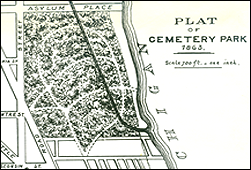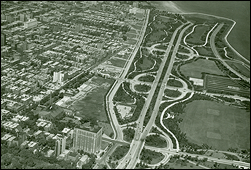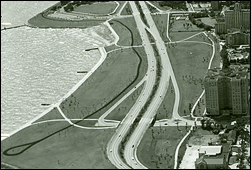
North DuSable Lake Shore Drive History
-
Lake Shore Drive has a rich and complex history that has been influenced by civic leaders, governmental organizations, visionary architects, and shrewd businessmen.
- In the 1850s, Dr. John Rauch led calls to close Chicago's lakeside cemeteries and relocate the shallow graves of cholera victims and others. In 1860, the city banned further burials along the lake and set aside 60 acres of unused cemetery property as greenspace, naming the park for President Abraham Lincoln shortly after his assassination.
-
Landscape architect Swain Nelson developed the first plan for Lincoln Park in 1865. Nelson and his partner, Olaf Benson, were soon supervising construction of a lakefront drive between Wisconsin Street and Diversey Avenue.
- In 1869, the Lincoln Park Commission was established and given authority over lakefront land between North and Diversey Avenues.
- The Lincoln Park Commission promoted Olaf Benson to Park Superintendent in 1875. Benson oversaw construction of Lake Shore Drive south of the park, between North Avenue and Oak Street, and developed a new park plan that included a lakefront roadway connecting the north and south sections of Lake Shore Drive.
- The beginnings of Lake Shore Drive as we know it today date to 1882, when wealthy hotelier and property owner Potter Palmer built an impressive mansion on the lakefront drive south of North Avenue, near Burton Place. It wasn't long before other wealthy Chicagoans built homes nearby, in what is now known as the Gold Coast.
- During the 1880s and 1890s, wealthy property owners helped finance a seawall and landfill behind it so that Lake Shore Drive could be extended south of Oak Street. They hoped that property values would increase with a scenic drive at their front door.
- Daniel Burnham and his 1909 Plan of Chicago realized the value of a continuous linear park along the lakefront from Jackson Park on the south through Grant Park and north through Lincoln Park to the city limits. Burnham not only envisioned a city that would be efficient and attractive to residents, but one that would also result in tourism and commerce. Burnham also envisioned a "boulevard through a park," which would become Lake Shore Drive.
- By 1910, North DuSable Lake Shore Drive extended from Ohio Street through Lincoln Park to Belmont Avenue.
- In 1911, after long legal battles, Aaron Montgomery Ward won the fight to reclaim the City's lakefront for open space and public use. Thanks to Ward's perseverance, the Illinois Supreme Court declares the downtown lakefront as "forever open, clear and free of buildings."
- In the early 1930s, the State of Illinois helped the Lincoln Park Commission construct a new section of Lake Shore Drive between Montrose and Foster, which included the first series of cloverleaf intersections in the United States. Later that decade, through funding from the Federal Works Progress Administration (WPA), the Chicago Park District improved Lake Shore Drive between North Avenue and Montrose as a limited access highway.
- In the mid-1950s, the Chicago Park District extended Lake Shore Drive north from Foster Avenue to Hollywood Avenue.
- Jurisdiction of Lake Shore Drive was transferred from the Chicago Park District to the City of Chicago in 1959.
- Sometime during the 1960-1970s, jurisdiction of the Drive was transferred to the Illinois Department of Transportation.
- Friends of the Parks was established in 1975 with a mission to preserve public park lands and add new parkland wherever and whenever practicable, especially in neighborhoods with the greatest need and along the lakefront.
- In 1979, Friends of the Parks advocated for resurfacing and marking the 18-mile Chicago Lakefront Trail from Hollywood Avenue on the north to 71st Street on the south.
- Through the collaborative efforts of Friends of the Parks, the Chicago Park District, the Illinois Department of Transportation and the Chicago Department of Transportation, aesthetically pleasing medians were implemented along North DuSable Lake Shore Drive in the early 1990s. The medians feature trees, shrubs, and groundcover as well as perennial plantings.
- After installation of the landscaped medians, Mayor Richard M. Daley reduced the speed limit on Lake Shore Drive in the wintertime to reduce splashing of road salt that would damage the vegetation.
- Since the 1990s, the Drive has undergone little change other than routine maintenance or isolated construction activities. Increased utilization of both Lincoln Park and the Drive has strained the relationship between park, trail and roadway.
- The current study of the infrastructure of North DuSable Lake Shore Drive offers the opportunity to improve Lake Shore Drive.



